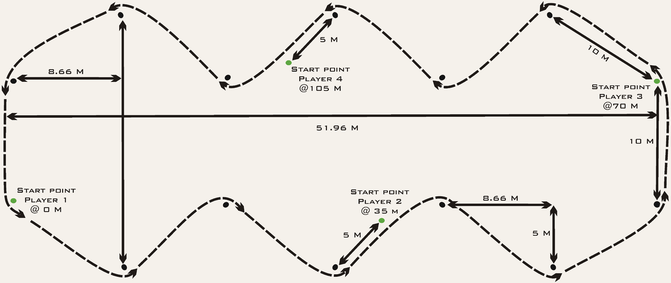The Probst field test
Like other tests, the Probst field test is named after its inventors H. Probst.
To our knowledge the test was first published in French in 1989 (5 - see references below), however later also used in English publications.
The test can be characterized as an intermittent test including change of directions. The total length is 140-meter and consists of 15 changes of direction. The initial speed of the test is set
to 8.4 km/h and is adjusted after every 280 meters (and therefore 2 laps) with 0.6 km/h, after a 30-second recovery period (2). The running velocity is controlled with an acoustic signal.
The final score of the Probst field test is the running velocity at which the player is able to finish a stage.
In our example, we have displayed how to use the test with 4 players at the same time to save time whilst testing.
The test seems to be valid in male regional to national level footballers (2, 3), however, significantly overestimates the maximal aerobic velocity (2).
Other investigations in football used the Probst test to monitor players improvements over an entire football season (4).
References
1. Aagaard, P., Simonsen, E.B., Anderson, J.L., Magnusson, P., Halkjaer-Kristensen, J., and Dyhre-
Poulsen, P. Neural inhibition during maximal eccentric and concentric quadriceps contraction: effects of resistance training. J. Appl. Physiol. 89: 2249-2257, 2000.
2. Labsy, Z., Collomp, K., Frey, A., and De Ceaurriz, J. Assessment of maximal aerobic velocity in soccer
players by means of an adapted Probst field test. J. Sports. Med. Phys. Fitness. 44: 375-382, 2004.
3. López, J.G., Rodríguez Marroyo, J.A., Morante Rábago, J.C., Montesinos, G., Vicente, J.M., and Villa
Vicente, J.G. Validity of lactic acid in an interval stress test (Probst test) to determine a soccer player's anaerobic threshold. International Journal of Soccer and Science 2: 3-16, 2004.
4. Nunez, V.M., Da Silva-Grigoletto, M.E., Castillo, E.F., Poblador, M.S., and Lancho, J.L. Effects of training
exercises for the development of strength and endurance in soccer. J. Strength. Cond. Res. 22: 518-524, 2008.
5. Probst, H. Test par intervalles pour footballeurs. Revue Macolin 5: 7-9, 1989.
 Footballscience.net
Footballscience.net

